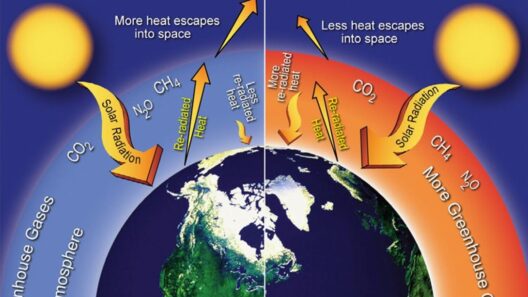Canada, the second-largest country in the world, is renowned for its breathtaking landscapes and diverse climatic conditions. Spanning six time zones and covering approximately 9.98 million square kilometers, Canada’s geography is as varied as its climate. From the frigid Arctic tundra to temperate coastal regions, the climate across Canada showcases an array of ecosystems that adapt to the myriad of weather patterns. Understanding the climate in Canada requires an examination of its different regions, seasonal changes, and climatic challenges.
In general, Canada experiences a continental climate characterized by four distinct seasons: winter, spring, summer, and autumn. Each season brings its own unique weather phenomena, influenced largely by geographic location and elevation. Many Canadians eagerly anticipate the changing of the seasons, as it shapes their outdoor activities, cultural events, and economic activities.
Regional Climates
Canada’s vastness means that climatic conditions differ significantly across various regions. Broadly speaking, the country can be divided into five major climatic zones: Arctic, subarctic, humid continental, oceanic, and steppe. Understanding these zones provides a clearer insight into regional weather patterns.
In the Northern territories, such as Yukon, Northwest Territories, and Nunavut, the Arctic climate prevails. Characterized by long, harsh winters and short, mild summers, these areas endure extreme cold. The temperature can plummet to negative 30 degrees Celsius and lower, making it a formidable environment. However, the summer months present a contrasting reality, where the sun barely sets, offering several weeks of continuous daylight.
Just south of the Arctic Circle lies the subarctic zone, which includes parts of northern Quebec and Manitoba. Winters remain cold and lengthy, although the summers are shorter and allow for a burst of flora and fauna to thrive, a phenomenon critical to indigenous cultures and wildlife.
The humid continental climate is prominent in regions such as Ontario, Quebec, and parts of the Prairie provinces. This area experiences significant seasonal temperature variations. Winters can bring heavy snowfall, while summers can be sweltering, prompting the vibrant social activities that characterize Canadian summers. The Great Lakes region, in particular, creates a microclimate that can lead to humid and hectic weather in the warmer months.
Further west, the Pacific coast, encompassing British Columbia, is shaped by an oceanic climate. Here, winters are moderate and summers relatively cool. The impact of the Pacific Ocean cannot be overstated, as it results in increased precipitation, particularly along the coastal mountains. Rainfall patterns enrich lush rainforests and diverse ecosystems that are home to a multitude of species.
Finally, the Prairie provinces—Alberta, Saskatchewan, and Manitoba—experience a steppe climate, defined by hot summers and cold winters, with limited precipitation. Agriculture, particularly wheat and canola production, thrives in this region, underlining the importance of climate in shaping economic activities.
Seasonal Variations
The shift from one season to another brings about profound changes not only in weather patterns but also in Canada’s cultural and social dynamics. As winter blankets the land, Canadians embrace the cold with a multitude of activities; skiing, snowboarding, and ice fishing are just a few pastimes that transform the breathtaking landscapes into hubs of winter sports.
As spring approaches, thawing ground and warming temperatures signal the rejuvenation of nature. Melting snow and blooming flowers herald the return of life, particularly in agricultural areas where farmers prepare for planting. This transitional season, although brief, is vital for the flora and fauna that depend on the shift from dormancy to growth.
Summer is a season of abundance in Canada. The long daylight hours fuel vibrant ecosystems. Flowers bloom in profusion, crops flourish, and residents partake in festivals, outdoor concerts, and recreational activities. The expansive wilderness offers opportunities for hiking, camping, and enjoying the natural beauty that draws both locals and tourists alike. However, summer can also bring about intense storms, particularly in storm-prone areas such as the warm, humid regions of Ontario and Quebec.
As autumn descends, Canada once again transforms as foliage changes from green to an array of reds, oranges, and yellows. The cooler temperatures signify the onset of harvesting. The rich agriculture of the country, from orchards to grain fields, culminates in harvest festivities, fortifying communities through shared cultural events and traditions.
Climate Challenges
Wildfires have become more prevalent, particularly in the west, exacerbated by dry conditions and prolonged heat waves. These wildfires not only threaten wildlife but also human settlements and air quality. A vigilant approach to forestry management and climate adaptation strategies is essential to mitigate these risks.
Canada’s commitment to addressing climate change is reflected in its policies aimed at reducing carbon emissions and promoting sustainable practices. As the nation grapples with these challenges, its resilience is evident in both its inhabitants and its dedication to preserving natural landscapes and biodiversity for future generations.
In conclusion, the climate in Canada is an intricate tapestry, woven from diverse regional characteristics, seasonal changes, and climatic challenges. Understanding this complexity is crucial for appreciating the cultural and environmental richness of Canada’s vast landscape. The dedication to not only recognize but also tackle environmental issues signifies a hopeful outlook for the future, illustrating the profound link between Canadians and their iconic land.







